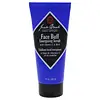What's inside
What's inside
 Key Ingredients
Key Ingredients

 Benefits
Benefits

 Concerns
Concerns

 Ingredients Side-by-side
Ingredients Side-by-side

Water
Skin ConditioningPolyethylene
AbrasiveGlyceryl Stearate
EmollientDisodium Cocoamphodiacetate
CleansingHexylene Glycol
EmulsifyingSodium C14-16 Olefin Sulfonate
CleansingCetyl Alcohol
EmollientCeteth-2
EmulsifyingMenthyl PCA
HumectantCalendula Officinalis Extract
Skin ConditioningDipotassium Glycyrrhizate
HumectantAllantoin
Skin ConditioningAscorbic Acid
AntioxidantMenthol
MaskingCaprylic/Capric Triglyceride
MaskingSodium Acrylate/Sodium Acryloyldimethyl Taurate Copolymer
Emulsion StabilisingMagnesium Aluminum Silicate
AbsorbentIsohexadecane
EmollientPolysorbate 80
EmulsifyingPropylene Glycol
HumectantCaprylyl Glycol
EmollientParfum
MaskingPhenoxyethanol
PreservativeChlorphenesin
AntimicrobialWater, Polyethylene, Glyceryl Stearate, Disodium Cocoamphodiacetate, Hexylene Glycol, Sodium C14-16 Olefin Sulfonate, Cetyl Alcohol, Ceteth-2, Menthyl PCA, Calendula Officinalis Extract, Dipotassium Glycyrrhizate, Allantoin, Ascorbic Acid, Menthol, Caprylic/Capric Triglyceride, Sodium Acrylate/Sodium Acryloyldimethyl Taurate Copolymer, Magnesium Aluminum Silicate, Isohexadecane, Polysorbate 80, Propylene Glycol, Caprylyl Glycol, Parfum, Phenoxyethanol, Chlorphenesin
Water
Skin ConditioningPhytelephas Aequatorialis Seed Powder
Propylene Glycol
HumectantCarbomer
Emulsion StabilisingSodium Laureth Sulfate
CleansingTriethanolamine
BufferingCamellia Sinensis Leaf Extract
AntimicrobialCocos Nucifera Fruit Extract
EmollientGinkgo Biloba Leaf Extract
Skin ConditioningZingiber Officinale Root Extract
MaskingAloe Barbadensis Leaf Juice
Skin ConditioningCaprylyl Glycol
EmollientHexylene Glycol
EmulsifyingPhenoxyethanol
PreservativeParfum
MaskingWater, Phytelephas Aequatorialis Seed Powder, Propylene Glycol, Carbomer, Sodium Laureth Sulfate, Triethanolamine, Camellia Sinensis Leaf Extract, Cocos Nucifera Fruit Extract, Ginkgo Biloba Leaf Extract, Zingiber Officinale Root Extract, Aloe Barbadensis Leaf Juice, Caprylyl Glycol, Hexylene Glycol, Phenoxyethanol, Parfum
Ingredients Explained
These ingredients are found in both products.
Ingredients higher up in an ingredient list are typically present in a larger amount.
Caprylyl Glycol is a humectant and emollient, meaning it attracts and preserves moisture.
It is a common ingredient in many products, especially those designed to hydrate skin. The primary benefits are retaining moisture, skin softening, and promoting a healthy skin barrier.
Though Caprylyl Glycol is an alcohol derived from fatty acids, it is not the kind that can dry out skin.
This ingredient is also used as a preservative to extend the life of products. It has slight antimicrobial properties.
Learn more about Caprylyl GlycolHexylene Glycol is a surfactant. Glycols are a class of alcohols. Hexylene Glycol is a surfactant and emulsifier.
As a surfactant, Hexylene Glycol helps gather dirt and oil on your skin to be washed away.
As an emulsifier, Hexylene Glycol helps keep water and oil together. This prevents them from separating in a product. Hexylene Glycol also thins out the texture of a product by lessening viscosity.
Hexylene Glycol has a small molecular weight.
Learn more about Hexylene GlycolParfum is a catch-all term for an ingredient or more that is used to give a scent to products.
Also called "fragrance", this ingredient can be a blend of hundreds of chemicals or plant oils. This means every product with "fragrance" or "parfum" in the ingredients list is a different mixture.
For instance, Habanolide is a proprietary trade name for a specific aroma chemical. When used as a fragrance ingredient in cosmetics, most aroma chemicals fall under the broad labeling category of “FRAGRANCE” or “PARFUM” according to EU and US regulations.
The term 'parfum' or 'fragrance' is not regulated in many countries. In many cases, it is up to the brand to define this term.
For instance, many brands choose to label themselves as "fragrance-free" because they are not using synthetic fragrances. However, their products may still contain ingredients such as essential oils that are considered a fragrance by INCI standards.
One example is Calendula flower extract. Calendula is an essential oil that still imparts a scent or 'fragrance'.
Depending on the blend, the ingredients in the mixture can cause allergies and sensitivities on the skin. Some ingredients that are known EU allergens include linalool and citronellol.
Parfum can also be used to mask or cover an unpleasant scent.
The bottom line is: not all fragrances/parfum/ingredients are created equally. If you are worried about fragrances, we recommend taking a closer look at an ingredient. And of course, we always recommend speaking with a professional.
Learn more about ParfumPhenoxyethanol is a preservative that has germicide, antimicrobial, and aromatic properties. Studies show that phenoxyethanol can prevent microbial growth. By itself, it has a scent that is similar to that of a rose.
It's often used in formulations along with Caprylyl Glycol to preserve the shelf life of products.
Propylene Glycol is an odorless, colorless liquid. As a humectant, it helps skin retain moisture. It also aids in delivering active ingredients.
Another role of this ingredient is preventing a product from melting or freezing. Propylene glycol also adds antimicrobrial properties to a product, elongating product lifespan.
This ingredient is considered an organic alcohol and commonly added into both cosmetics and foods.
Those with sensitive skin or conditions may develop a rash when using this ingredient.
Learn more about Propylene GlycolWater. It's the most common cosmetic ingredient of all. You'll usually see it at the top of ingredient lists, meaning that it makes up the largest part of the product.
So why is it so popular? Water most often acts as a solvent - this means that it helps dissolve other ingredients into the formulation.
You'll also recognize water as that liquid we all need to stay alive. If you see this, drink a glass of water. Stay hydrated!
Learn more about Water